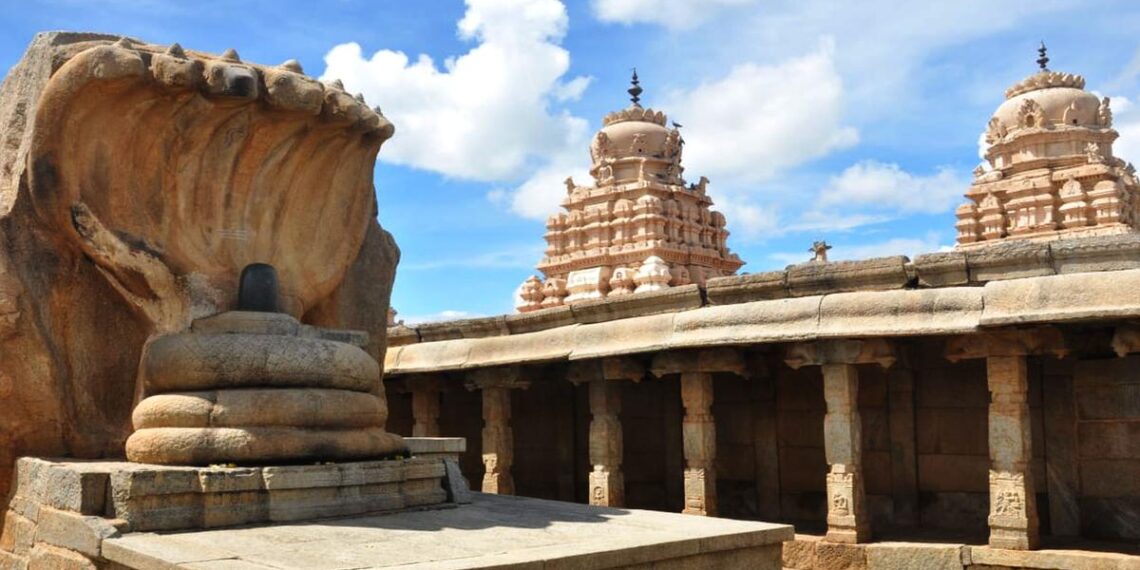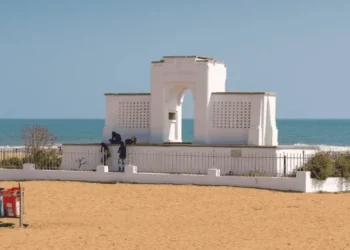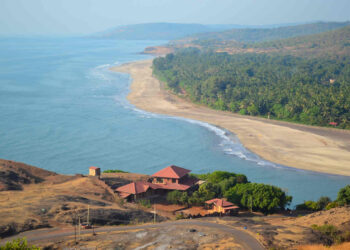The Lepakshi Veerabhadra Temple in Anantapur is a holy abode for Lord Veerabhadra, a fierce form of Lord Shiva. Set in the low hills of Lepakshi, 200 meters high with views of rocky plains, this 16th-century shrine covers about 3 acres along with its grand gopuram, vivid frescoes, and calm courtyards, it reflects the cultural legacy of Andhra Pradesh, a land of ancient tales in South India. Known for its Maha Shivaratri festival and hanging pillar marvel, the temple is one of the most revered among the Andhra temples.
Legend of the Temple
The Lepakshi Veerabhadra Temple is filled with sacred stories. One major tale is derived from the Skanda Purana. After Ma Sati’s death, Lord Shiva’s rage birthed Veerabhadra, who destroyed Daksha’s sacrifice yajna and since then have been worshipped by Shiva’s devotees. Another story tells of two brothers, Virupanna and Viranna, Vijayanagara officials in 1538. They saw Veerabhadra in a dream, urging them to build a shrine. They did, naming the temple Lepakshi after a bird’s cry, “Lepa-akshi” (sleeper, awake), heard during the construction of the temple. Locals say the temple’s hanging pillar, which doesn’t touch the ground, proves divine blessing and a unique marvel unraveled by archeologists, as ASI tests confirm.
History of the Lepakshi Veerabhadra Temple
The temple’s roots lie in the 16th century with the Vijayanagara Empire, though worship may have started earlier. A stone writing from 1538 CE credits Virupanna, a Vijayanagara treasurer, for building it under King Achyutaraya. Old records say priests kept its rituals alive. The Chalukyas, from the 7th to 12th centuries, left early carvings nearby, hinting at older worship, as temple stones show. The Vijayanagara kings, from the 14th to 16th centuries, made it a grand site, old books tell.
In the 1600s, the temple was a lively spot, with farmers, artisans, and devotees keeping it strong, Anantapur’s logs say. In 1565, after the Vijayanagara fall at Talikota, local chiefs protected it. The Qutb Shahis held Lepakshi briefly in the 17th century, then the British came by 1858, but the prayers held firm. After 1947, Andhra’s government took over, and the ASI now cares for it. Telugu songs by saints like Purandara Dasa, who sang for Shiva, tied it to Andhra’s Bhakti ways. As a key Shaiva shrine, it draws thousands seeking Veerabhadra’s strength, making it a big part of Lepakshi’s culture.
Architecture of the Temple
The Lepakshi Veerabhadra Temple showcases Vijayanagara style, covering 3 acres. Its five-story gopuram, 25 meters tall, is carved with Veerabhadra’s battles, dancers, and yali beasts, painted red and white. A stone door, etched with gods, leads to the sanctum, where the 1538 Veerabhadra idol, 6 feet tall, glows with lamps. A small shrine for Goddess Bhadrakali, built in 1540, is near. The main holy room has stone pillars with Shiva Purana scenes and Vijayanagara signs.
The natya mantapa, with 70 pillars, includes the famous hanging pillar, defying gravity, and carvings of Ramayana tales. A 20-foot Nandi statue, carved in 1540, sits 1 km away, facing Shiva. The courtyard has a holy tank, Naga Pushkarini, for washing before prayers. The mukha mantapa’s ceiling frescoes, from 1538, show Vishnu’s avatars and Vijayanagara life, kept vivid by the ASI. Wall carvings from the 1500s depict Shiva’s dance, making every corner a piece of the past. The temple’s hilltop spot, looking over Lepakshi’s plains, joins it to the town’s old days near the Penna River.
Festivals and Rituals
The temple comes alive during festivals, especially Maha Shivaratri in February or March, a grand day from Vijayanagara times. On this day, Veerabhadra’s murti (idol) is bathed in ghee, with priests chanting mantras and offering bilva leaves. Many come, and flutes fill the air. Navaratri is very special for Bhadrakali as devotees come in throngs to visit the mother goddess. Telugu bhajans and Odissi dances, sharing Veerabhadra’s tales, echo through the mantapas.
Getting to the Temple
Lepakshi is best reachable from Bengaluru Airport, 120 km away, and has flights from Delhi (2.5 hours) or Hyderabad (1 hour). Taxis take 2 hours to the temple. Hindupur Railway Station, 14 km away, links to Bangalore (2 hours), Hyderabad (8 hours), and Chennai (7 hours). Autos or taxis from Hindupur take 20 minutes. Buses from Anantapur (100 km, 2 hours) or Bangalore (120 km, 2.5 hours) stop at Lepakshi village, 1 km away. Autos cost 20-50 rupees to the temple. No entry fee, but pujas may cost 50-300 rupees.
Practical Tips for Visiting
Andhra Pradesh gets hot, up to 85-100°F, with rains from June to September. November to February is cooler, around 70-85°F. Go at 6 AM to skip crowds and heat. Wear clothes covering shoulders and knees; dhotis or saris are best. Maha Shivaratri gets full, so book pujas early. Bring water and a hat for the short climb.
Final Thoughts
The Lepakshi Veerabhadra Temple is a spiritual and cultural gem that reflects Andhra’s sacred past and cultural legacy which is still relevant in modern times which can be proved by the thousands of devotees who still grace with their presence to pay homage to the fierce protector Veerabhadra making it a must-visit among Andhra’s shrines.











